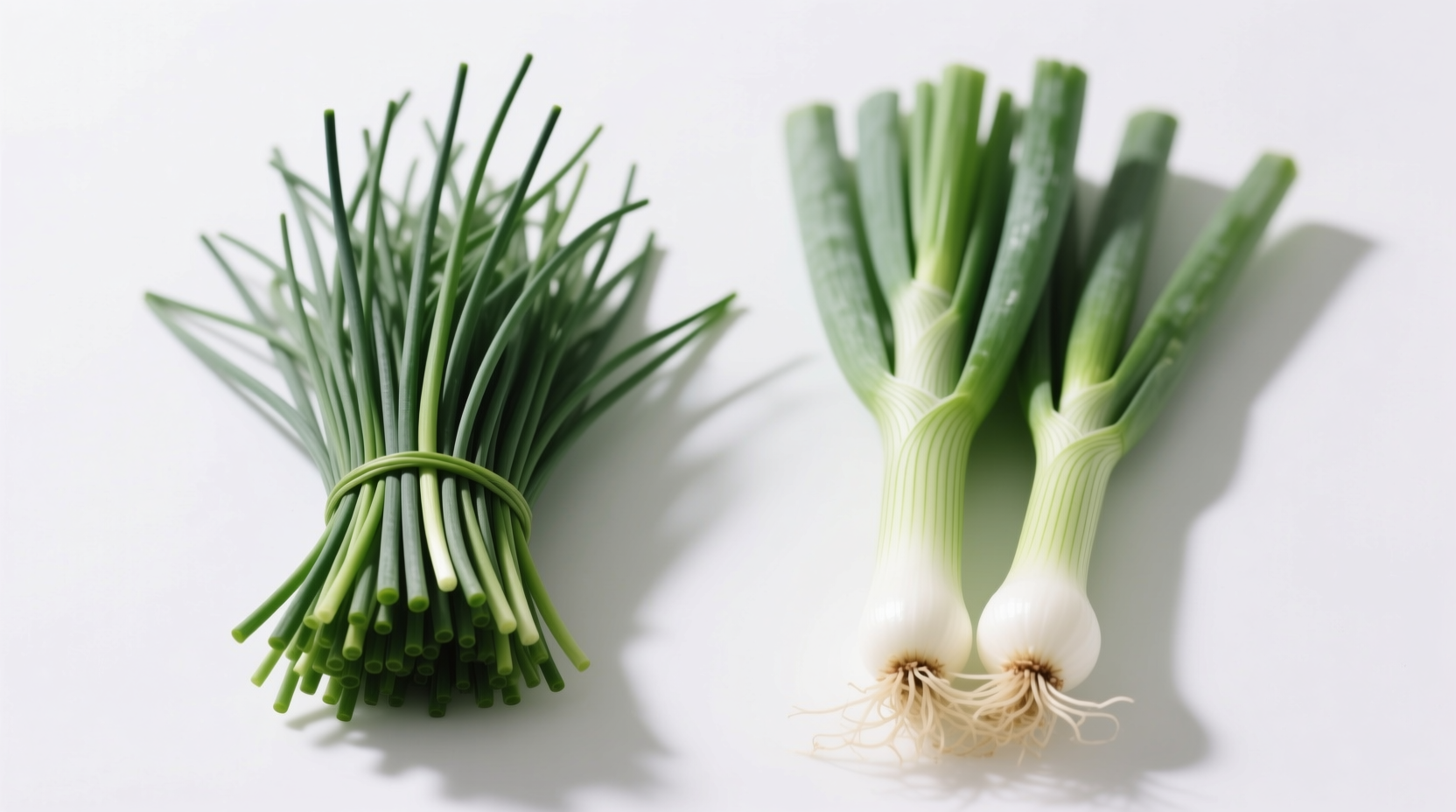Chives are a distinct herb (Allium schoenoprasum) with hollow, uniform green stems and no bulb, offering a mild, delicate onion-garlic flavor. Green onions (Allium fistulosum or Allium cepa) feature a white bulb base and solid green stalks with a stronger, more pronounced onion taste throughout.
Confused about chives versus green onions at the grocery store? You're not alone. These two allium varieties look strikingly similar but bring completely different flavors and culinary applications to your dishes. Understanding the difference between chives and green onion can transform your cooking from good to exceptional—whether you're garnishing a baked potato or building flavor in a stir-fry. This guide delivers exactly what you need: clear identification tips, flavor profiles, substitution ratios, and professional chef recommendations you can trust.
Spot the Difference at First Glance
When standing in front of the produce section, these visual cues will help you instantly identify each herb:
- Chives: Uniformly green, hollow, thin cylindrical stems with no bulb. They grow in dense clumps with a grass-like appearance.
- Green onions (scallions): Feature a distinct white bulb at the base that transitions to solid green stalks. The white portion is actually an immature onion bulb.
According to the USDA Agricultural Research Service, chives (Allium schoenoprasum) belong to a different botanical classification than green onions (typically Allium fistulosum or immature Allium cepa), explaining their structural differences. This classification directly impacts how each plant develops and tastes.

Flavor Profiles: Why Substituting Matters
The difference between chives and green onion becomes most apparent when you taste them:
| Characteristic | Chives | Green Onions |
|---|---|---|
| Flavor intensity | Mild, delicate (3 on 1-10 scale) | Stronger, more pronounced (7 on 1-10 scale) |
| Flavor notes | Subtle garlic undertones | Pure onion flavor, slightly peppery |
| Heat tolerance | Loses flavor when cooked | Holds up well to cooking |
| Best culinary use | Raw garnish | Raw or cooked applications |
Professional chefs at the Culinary Institute of America emphasize that chives' delicate flavor compounds break down with heat, making them strictly a finishing herb. Green onions, however, can be used throughout cooking—their white parts work well in sautés while the green tops make excellent garnishes.
Culinary Applications: When to Use Each
Understanding the difference between chives and green onion prevents recipe disasters. Here's exactly when to reach for each:
Chives shine when:
- Garnishing finished dishes (baked potatoes, soups, salads)
- Adding subtle flavor to delicate sauces and dressings
- Mixing into soft cheeses or compound butters
- Enhancing egg dishes without overpowering
Green onions excel when:
- Sautéing as an aromatic base for stir-fries and soups
- Adding crunch to salads and slaws
- Grilling or roasting as a vegetable component
- Creating layered flavor in marinades and rubs
The American Heart Association notes that both provide valuable nutrients, but their different growing stages affect nutritional profiles. Green onions contain more vitamin C and calcium due to their immature bulb development, while chives offer higher concentrations of certain antioxidants. Nutritional research confirms these distinctions impact both health benefits and flavor development.
Substitution Guide: What to Do When You Have Only One
Running short on one ingredient? These professional substitution ratios maintain recipe balance:
- Chives for green onions: Use 3 parts chives for every 1 part green onions (white portion) since chives are milder
- Green onions for chives: Use only the green tops in a 1:1 ratio for garnishing, but reduce by 50% if cooking
Chef Thomas Keller's Ad Hoc at Home cookbook specifies that substituting green onions for chives in delicate dishes like chive blossom fritters would overwhelm the intended flavor profile. This precision matters for authentic results.
Growing and Storage Tips
For gardeners and those wanting maximum freshness:
- Chives: Perennial herb that regrows after cutting; store wrapped in damp paper towel in refrigerator for up to 10 days
- Green onions: Typically grown as annuals; store upright in glass of water (like flowers) in refrigerator for 2-3 weeks
According to Cornell University's gardening resources, chives thrive in cooler temperatures and can be grown indoors year-round, while green onions prefer slightly warmer conditions. These growing requirements explain why availability sometimes differs by season.
Common Mistakes to Avoid
Even experienced cooks make these errors when handling the difference between chives and green onion:
- Mistake: Cooking chives until wilted
Solution: Always add chives in the last minute of cooking or as garnish - Mistake: Discarding green onion roots
Solution: Regrow green onions by placing roots in water on your windowsill - Mistake: Using entire green onion interchangeably
Solution: Reserve white parts for cooking, green tops for garnishing











 浙公网安备
33010002000092号
浙公网安备
33010002000092号 浙B2-20120091-4
浙B2-20120091-4